|
Author
|
Topic: Product Review: Color Rebalance Filter
|
Douglas Meltzer
Moderator

Posts: 4554
From: New York, NY, USA
Registered: Jun 2003
|
 posted October 28, 2008 11:26 AM
posted October 28, 2008 11:26 AM




This is an expanded version of my article in issue #23 of The Reel Image. We’ve all been curious about item #5002 on the Wittner-Cinetec site (www.wittner-cinetec.com), The Color Rebalance Filter. According to the description, just placing this beauty over your projector’s lens will greatly reduce the red from faded prints and make them watchable again. Does his mean I should dig my old red/pink/magenta prints out of the closet o’ film and thread them up? Can a filter really improve the image that much?
First let’s deal with the cost. The list price is 119,83 EUR., approx. $175.00, not including shipping. I’ve heard collectors complain about the high price, but as a cameraman who’s worked in the film & TV industry for over 20 years, I know that’s in line with the cost of quality glass filters. A Tiffen 4x4 Pro Mist filter can easily cost $190.00. So the price doesn’t seem excessive…. if it works!
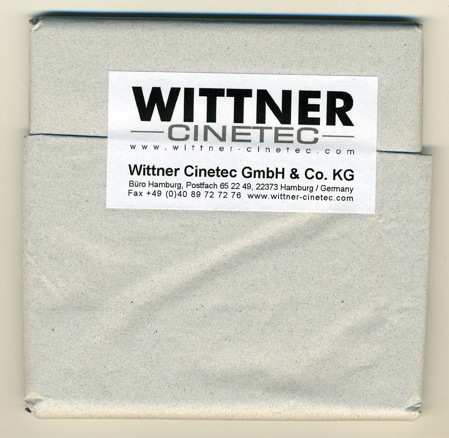
Steve Osborne of The Reel Image added my filter order to one he was placing with Wittner. The filter arrived nicely wrapped and packaged in a 200 ft. film can. It is a decent quality 100 x 100mm (3.94” x 3.94”) piece of glass, basically turquoise in color.
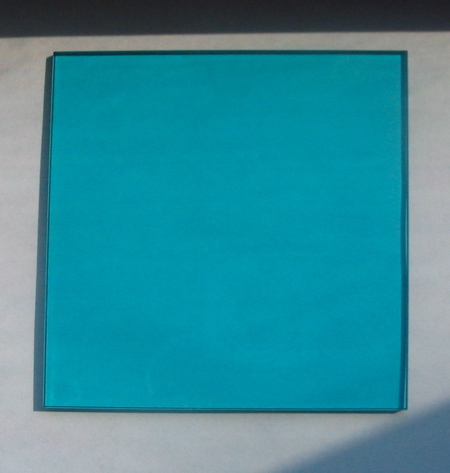
My first problem was how to mount the CRF in front of the projector lens. Wittner does not sell a mounting plate, suggesting a small stand or even tape will do the trick. The filter is just a touch too small for my 4x4 filter holders, so I ended up making a cardboard sleeve that I rigged to a scope lens bracket.
Does the CRF work? This filter does one thing very well. It gets the red out. Mostly noticeable in the black areas of faded prints, the red is significantly reduced. Now that you’ve removed a particular wavelength of the color spectrum, what’s left? That depends on how badly faded that print of yours is. If the color is totally faded, you’re merely replacing the red tinge with a blue/green tint. If there’s only slight fade, you might not like the effect on the flesh tones. Films that are warm but still retain other colors seem to benefit the most. Color perception and appreciation being very subjective, one might rejoice at being rid of red or be sad to see a surge in cyan. Some might prefer a vivid faded print over the subdued look this filter can give. I came across some instances where I preferred the filtered image. I found the sharpness of the image is not affected by using the CRF. Owners of projectors that use lower wattage bulbs should note: there is a light loss of a full stop.
Examples:

My print of “The Boston Strangler” is completely faded. Wittners’ CRF removes the red, but replaces it with a blue/green tint. It’s a close call, but I’d rather watch the feature without the filter.

-
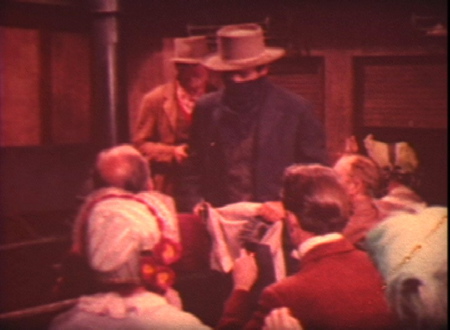
Ken Films’ “Jesse James” digest has some fade but is still holding on to greens & blues. The CRF does a nice job of removing the red cast (particularly in the darker areas). The
overall color is muted but the image is quite acceptable with the filtration.
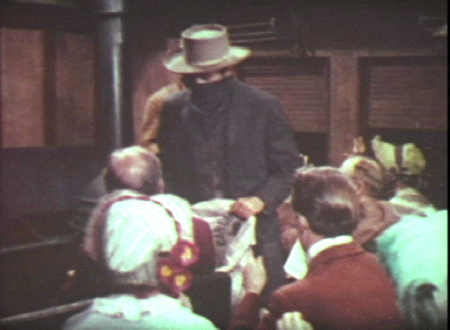
--------------------
I think there's room for just one more film.....
| IP: Logged
|
|
Douglas Meltzer
Moderator

Posts: 4554
From: New York, NY, USA
Registered: Jun 2003
|
 posted October 28, 2008 11:28 AM
posted October 28, 2008 11:28 AM




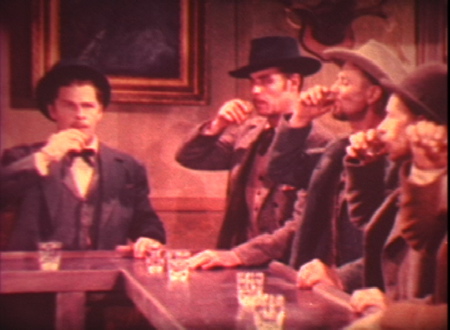
Another scene from the same print of “Jesse James”, however there’s not much color to be found here. The filter gives the flesh tones too green a cast that makes me think these fellows should stop drinking right away.
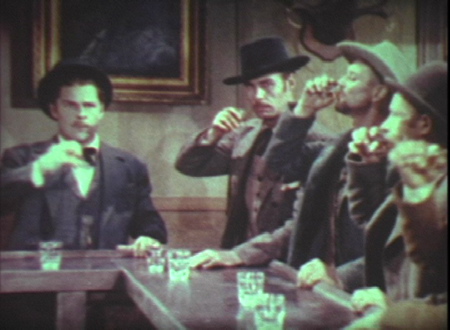
-
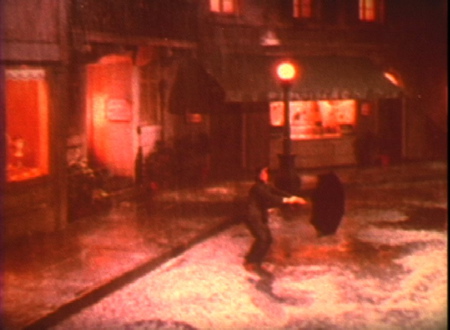
The filter works best on night scenes. My MGM digest of “Singin’ in the Rain” has strong colors, but the darker scenes have a decidedly reddish cast. The CRF pulls the red out to give a very pleasing picture, even with the cyan tint in the highlights.
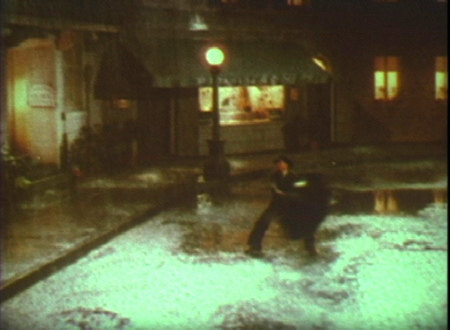
-
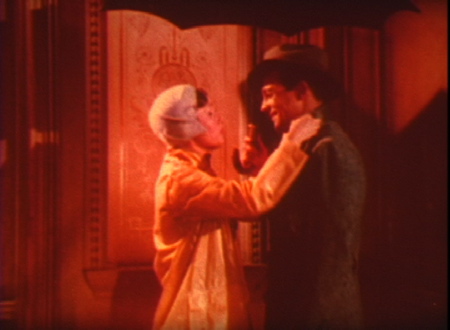
A very warm looking scene loses the red but keeps natural looking flesh tones.
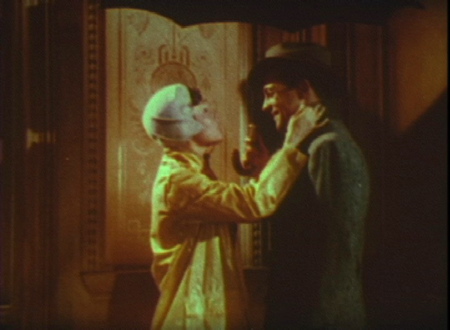
-
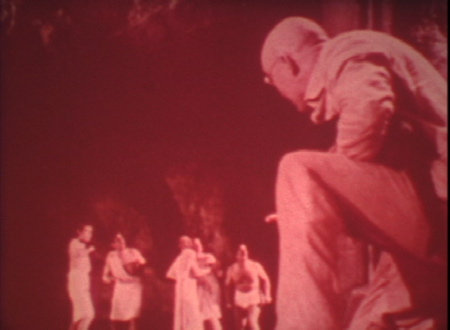
The color version of Universal 8’s “Dr. Cyclops” was infamous for it’s sepia tint when it was originally released. The CRF removes the fade and practically turns it into a nice black & white print! In fact, I have a few B&W films that were printed on color stock that has since faded and I can see using the CRF when screening those.
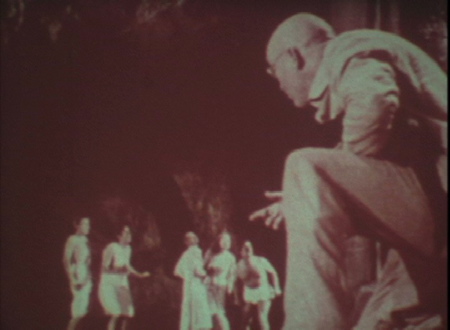
Summary: Once that print has faded to red, there’s nothing that can bring back the color. The CRF has its uses, but in a narrow range. There have to be other colors beside red in your print for it to work properly. For the average collector, unless you cringe at the sight of red on your home screen, the Color Rebalance Filter is a nice-to-have, not a must-have.
Doug
--------------------
I think there's room for just one more film.....
| IP: Logged
|
|
|
|
|
|
|
|
|
|
|
|
|
|
|
|
|
|
|
|
|
|
|
|
|
|
|
|
|
|
|
|
|



 UBBFriend: Email this page to someone!
UBBFriend: Email this page to someone!
 Printer-friendly view of this topic
Printer-friendly view of this topic



 UBBFriend: Email this page to someone!
UBBFriend: Email this page to someone!
 Printer-friendly view of this topic
Printer-friendly view of this topic